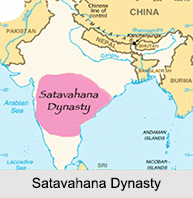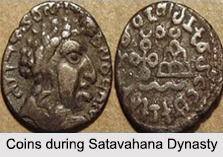 Satavahana Dynasty emerged in the southern part of India and expanded almost throughout the country. They ruled from Pune in Maharashtra to Coastal Andhra Pradesh. The Satavahana Empire was also known as the "Andhras" or the Andhra Dynasty. They were also called as the Andhras in Deccan and their capital was at "Paithan" or "Pratishthan". The Andhras were ancient people and they are mentioned in the Aitareya Brahmana. They played the most significant role in Indian history in the period between the fall of the Mauryas and the rise of the Gupta Empire.
Satavahana Dynasty emerged in the southern part of India and expanded almost throughout the country. They ruled from Pune in Maharashtra to Coastal Andhra Pradesh. The Satavahana Empire was also known as the "Andhras" or the Andhra Dynasty. They were also called as the Andhras in Deccan and their capital was at "Paithan" or "Pratishthan". The Andhras were ancient people and they are mentioned in the Aitareya Brahmana. They played the most significant role in Indian history in the period between the fall of the Mauryas and the rise of the Gupta Empire.
Origin of Satavahana Dynasty
Satavahana Dynasty was established in the 1st century BC in the western Deccan Plateau. As the name suggests it was evident that the Satavahana Rulers had emerged from the Andhra region or the delta areas of Krishna River and Godavari River. The Satavahana Dynasty was built up on the ruins of the Maurya Empire and around 1st century AD. The general belief about the Satavahana rulers is that the kingdom originated in the west and later on expanded their rule towards the east.
Rulers of Satavahana Dynasty
The rise of Satavahana Dynasty follows the pattern of chiefdom to kingdom. It has been recorded that the kings used to practice Vedic sacrifices as an act of legitimation. It was also believed that the Satavahanas had developed political ambitions because they carried out administrative functions during the reign of the Mauryas.
 Simuka was the founder of the Satavahana Dynasty and he is believed to have destroyed the Sunga Power. Gautamiputra Satakarni, one of the earliest Satavahana king had received wide recognition because of his policy of military expansion. Satakarni carried on expansion through the entire country and had become famous during that era as a king of great power and valour. After Satakarni, the Satavahana dynasty was succeeded by Vasishthiputra. He had said that Satakarni was the one who had stopped the contamination of the four Varnas and had furthered the interests of the twice-born. He had also said that during the rule of the first Satavahana king, the Deccan served as a corridor not only for the passage of politics but it also served as a link to spread tread and the religious faiths like Buddhism and Jainism.
Simuka was the founder of the Satavahana Dynasty and he is believed to have destroyed the Sunga Power. Gautamiputra Satakarni, one of the earliest Satavahana king had received wide recognition because of his policy of military expansion. Satakarni carried on expansion through the entire country and had become famous during that era as a king of great power and valour. After Satakarni, the Satavahana dynasty was succeeded by Vasishthiputra. He had said that Satakarni was the one who had stopped the contamination of the four Varnas and had furthered the interests of the twice-born. He had also said that during the rule of the first Satavahana king, the Deccan served as a corridor not only for the passage of politics but it also served as a link to spread tread and the religious faiths like Buddhism and Jainism.
Till the end of 2nd century, the Satavahana dynasty expanded from western India to the Krishna delta and northern Tamil Nadu but this expansion did not continue for long. In the very next century, the power of the Satavahana rulers weakened due to the increasing power of the local governors all of whom claimed independent states for them. The Satavahana territories were divided into small provinces, each under civil and military officers. During the Satavahana reign many of the courtiers were allowed to marry in the royal family because it was believed to be a way to show their loyalty to the king. They were also allowed to mint their own coins.
Decline of Satavahana Dynasty
The Satavahanas Dynasty collapsed when Abhiras seized Maharashtra and Ikshwakus and Pallavas appropriated the eastern province. Their greatest competitors were the Sakas who had established their power in upper Deccan and Western India. As the Satavahana dynasty fell down, the governors of the kingdom followed a similar pattern and each of them tried to form an independent unit of their own. The declining power of the Satavahana was targeted by the Abhiras and the Traikutakas of western India.






































